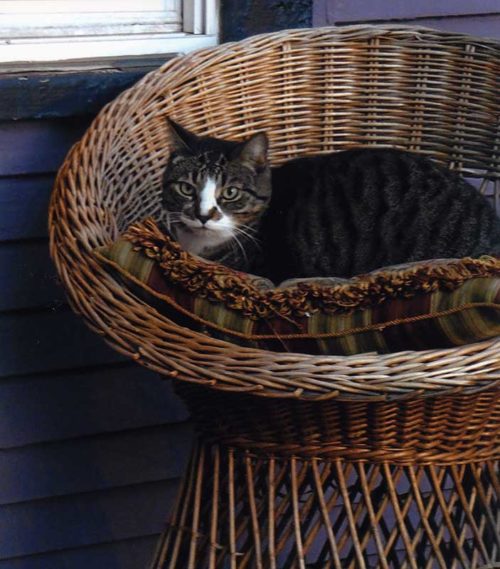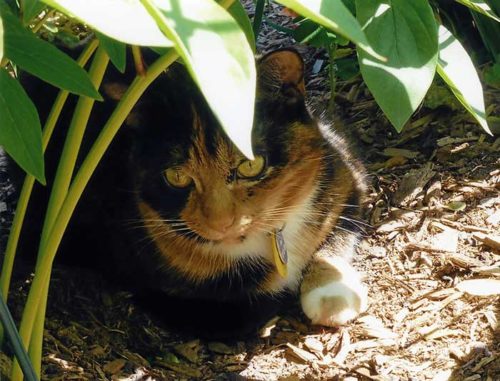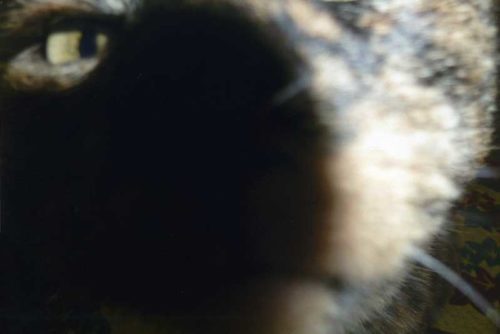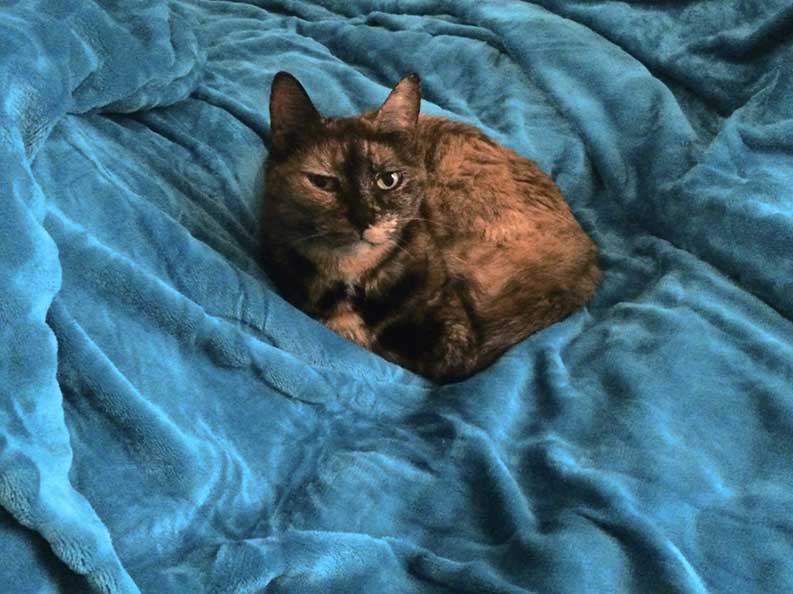Here’s Looking at You, Felis Catus
 I climb the stairs and come face to face with the stare. Hazel—an eight-pound, short-haired, high-strung tortoiseshell—crouches on the top step. She stares right at me, but could just as well be looking right through me.
I climb the stairs and come face to face with the stare. Hazel—an eight-pound, short-haired, high-strung tortoiseshell—crouches on the top step. She stares right at me, but could just as well be looking right through me.
If you live with a cat, you’ve probably experienced this moment: the cat, who looked sweetly up at you earlier, now stares you down. I do what you probably do—hesitate and then walk by and wait for the “other cat” to come back—but I’ve gotten curious. What is that stare? I’ve always imagined she sees as I see, but that turns out to be wrong. I’d like to inch outside my worldview and glimpse the world through my cat’s yellow-green eyes. What does Hazel see as I climb the stairs?
We take it for granted, but the fact that we communicate with animals at all is remarkable. In her book about the ways animals have shaped human evolution, The Animal Connection, paleoanthropologist Pat Shipman likens this communication to “beaming radio signals into deep space over and over on the chance that aliens will decipher them and answer us.” Some of the aliens did, and now they share our homes.
Our communication with dogs seems simpler, like translating related languages, because they’re social beings to the core. With cats, the translation is much harder: I can’t even hear certain phonemes and certainly can’t pronounce them. This goes both ways, I’m sure. Mutual understanding is tougher because cats aren’t social in the ways people and dogs are; wildcats are territorial loners. But if cats weren’t emotionally expressive and responsive to us, and we to them, we couldn’t live together.
Cats and people communicate in many ways. We talk to our cats—speak, sing, babble, coo, squeak, and occasionally yell—and they talk to us—chirp, meow, trill, purr, hiss, growl, and howl. When we first adopted Hazel as a two-year-old from the shelter, she barely made a peep; now, she rarely shuts up. The sounds she makes are varied, nuanced, and expressive. Cats also talk with their bodies, as they wind around our feet, rub their cheeks against an outstretched hand, extend a paw, curl their toes, roll on their backs, snuggle in our laps. Flattening their ears, biting, and scratching are equally eloquent. Finally, cats use a language of looking: They look, respond to looks, and exchange looks, just as we do with members of our own species.
Temple Grandin, who campaigns for scientifically based treatment of animals, especially livestock, argues that all domestic animals retain key qualities of their wild forbears. “You have to go back to the brain to understand animal welfare,” she insists in Animals Make Us Human. Consequently, despite thousands of years of breeding, they should be housed, treated, and respected in keeping with the core emotions of their species as it evolved.
The cat is actually less domestic than a dog, goat, or chicken. When people became farmers thousands of years ago, one species of mouse overcame its fear of humans and moved into the granaries. One species of cat, a long-legged brown tabby called Felis sylvestris lybica, overcame its fear and solitary ways to follow the mouse. It had to overcome not just its fear of humans but its resistance to being near other cats. Then, for thousands of years, cats probably lived like the mice they hunted, as mostly wild creatures around humans. Gradually, people adopted and raised kittens and brought cats more fully into our homes, but didn’t breed them until the 19th century because cats did what we wanted—kill mice—naturally. As a result, housecats resemble their wild ancestors more than other domesticated animals do. We haven’t changed them much. Hazel’s brain, senses, and emotions are essentially the brain, senses, and emotions of a wildcat.
Wildcat and housecat coexist in Felis catus. On the one side, the wildcat—a small territorial hunter and prey animal—stays perpetually alert to opportunity and danger. It keeps to itself and keeps watch. On the other, the housecat—well fed and used to living alongside humans and other animals—can kick back and relax. Domestication has made the housecat more docile, less reactive, and more dependent. This process also makes an adult housecat a bit like a wildcat that never quite grew up, a juvenile. As a result, your simple housecat is a complex being. Hazel embodies two “modes,” wild and domestic, and four “selves,” hunter, hunted, adult, and juvenile—and various combinations. It gets confusing sometimes.

Our neighbors’ not-so-wild housecat
Sometimes, Hazel watches me with the eyes of a (tame) wildcat. Our house is a hunting ground. A cat combines two hunting strategies, mobile and stationary. It moves through a stretch of brush, spots movement in the grass, and then lies in wait to ambush its prey. Hazel positions herself where a passage narrows and she has sightlines and escape routes in more than one direction: the top of the stairs, near the corner of the couch, behind the armchair by the doorway, on a windowsill. She likes to be under cover—hidden yet able to observe her surroundings—or off the floor—perched safely above the action. Is the space at the top of the stairs the mouth of a burrow?
Cat vision evolved for hunting, so cats see shapes well and detect movement quickly. They also, famously, see well in dim light. Though Hazel cannot magically see in the dark, she can see in “the merest glimmer” of light, according to John Bradshaw in his book Cat Sense. This is because her eyes are huge relative to the size of her head, her pupils open three times as wide as human pupils, and a sheet of reflective cells behind the retina increases her eyes’ light sensitivity by 40%. What’s more, the photoreceptor cells in Hazel’s eyes, called rods, work especially well in low light.
But her visual superpower has trade-offs: Hazel focuses poorly in bright light. And it’s hard work for her to focus those big eyes—and she really can’t focus on anything closer than a foot—so she doesn’t unless she has to. She saves her energy. This means that her look and attention are often generalized, her “stare” not really a stare at all. She gazes fuzzily into the middle distance and waits for something worth looking at, for movement.
As I climb the stairs, a small tame-wild creature brings her big eyes into focus and looks at me. Her nervous system goes on alert. Is the approaching shape prey or predator, opportunity or danger?
What’s more, a cat’s face lacks muscles. Anne Burrows, an anatomist who studies the expressiveness of animals’ faces, remarks about her study of cats: “It turned out they just don’t really move their faces at all.” For social animals, facial expressions are vital; for solitary territorial animals like Hazel, they’re pretty much irrelevant. Hazel takes my measure through an impassive mask. Social animal that I am, I am unnerved.
At other times, Hazel watches me with the eyes of a housecat, a cat adapted to living around others. Our cats must see the feline in their people—felinomorphically—just as people see the human in our pets, so Hazel treats me like another adult cat or her mother. At relatively close range adult cats exchange looks. At first they stare directly, but then half close their eyes, slowly blink a few times, and turn away. This behavior, according to James Serpell in In the Company of Animals, “denotes a mild form of submission or at least a desire to avoid conflict.” Humans tend to read it anthropomorphically. When I was a kid, I heard these blinks called “cat kisses.” Ever since, I have blinked back at my cats. (At least I’m signaling a desire to avoid conflict!)
Hazel also gives me a close-up look. When I extend my face toward hers, she peers into my face before stretching her nose toward my nose and mouth. I now know that my face is a complete blur at close range, so this is less an exchange of looks than of sniffs, which is in her repertoire not mine.

A fuzzy cat’s-eye close-up
She’ll also groom me occasionally, licking my cheek or near my eyes. (She grooms the dog this way, too.) Is this adult behavior, juvenile, a bit of both?
Kittens, of course, look to their mothers for food, warmth, and protection. When Hazel wants her breakfast or dinner, she positions herself by the cabinet door, looks up at me, stretches a paw toward the cabinet, extending her claws and curling her toes in a modified kneading motion, and meows. The gaze implores. But how do I know that if her face is immobile? The body language is clear and purposeful, of course, but the pupils may help. Serpell suggests that their pupils dilate when they want something—an effective ploy when their eyes are so large to begin with.
Hazel also lets me know when she wants to go to bed. Really, when she wants me to go to bed. She comes to find me, stands near the doorway, and gives me a look. She leaves, comes back, and gives me another look.
Most nights, I read before falling asleep. As soon as I’m settled with my book, Hazel marches up from the foot of the bed to claim my lap. She rubs her cheek against my knuckle or the corner of my book. She kneads my leg for a minute, intently and with her face averted, and then lies down. Before folding into sleep she looks up at me. She’s just far enough away to focus on my face. She slowly blinks. I blink. We look at each other for a few more seconds, until she blinks one last time, lowers her head, and closes her eyes. I’m not sure if it’s a cat kiss, a sign of mild submission, or the sleepy look of a kitten, but I am sure it’s one of life’s pleasures—the unhurried regard of a cat.

Hazel died recently from stomach cancer. I miss her, and being bossed around.
References (in the order of their first appearance):
Pat Shipman. The Animal Connection. Norton, 2011.
Temple Grandin. Animals Make Us Human. Mariner, 2009.
John Bradshaw. Cat Sense Basic Books, 2013.
James Gorman. “Those Puppy Eyes You Can’t Resist? Thank Evolution.” New York Times, Jun 17, 2019.
James Serpell. In the Company of Animals. Cambridge University Press, 1996.
